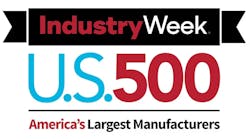What happens with U.S. research during the next four or five years, and how much it can spur industry and manufacturing over that time, is going to determine our place on the global stage for the next 50+ years. It's that serious. Relatively speaking, the Cold War was no more important to our future than a research race between the U.S. and China would be. Fortunately, we don’t have to let a research race escalate to the level of the Cold War. Significant new and sustained federal investment into research science right now will let us continue our legacy of invention, innovation and leadership.
But the evolving trade relationship between China and the U.S. presents a situation we’ve never faced before. It's a situation where we don’t have some sort of overwhelming advantage to leverage, or can leverage, to ensure things remain in our favor.
I came to manufacturing from the enterprise software world, where it was commonplace to hire Chinese software developers, database architects and information science specialists. That worked in everyone’s favor. We were able to get top flight talent; they got to ply their trade in the only market where the number, scale and sheer value of opportunities existed. But that was more than a decade ago and our monopoly on opportunities no longer exists.
To remain competitive we have to ask ourselves how to create new opportunities because that’s what our competitors are doing. Not opening up untapped markets or embracing the new paradigms of a product as a service business model or anything else that’s sales oriented. Creation of opportunities from things that currently exist only in models or on scales so small, or large, that they’re difficult to comprehend, much less shrink-wrapped for retail or ready to plug into a production process. The opportunities we must have are created in laboratories and skunkworks projects funded almost exclusively by the Federal government.
We forget that almost all of the foundational technologies that make our way of life possible were the result of the high-level research that private industry simply doesn’t invest in. They can’t invest in that level of research because the returns are seldom timeline friendly and the costs do not represent a responsible use of taxpayer dollars for a company, or even a group of companies.
The returns are spread out to everyone through things like the photolithography that allows circuit boards to be dirt cheap to the fiberoptic cables that make vast distributed computing networks and entire branches of banking possible.
Want more? How about:
- Remote sensing
- Aerospace
- Naval
- Nuclear medicine
- GPS navigation
- Quantum computing
- Radar
- Sonar
- Microwave ovens
- Safety glass
- Optomagnetic data storage,
- Autonomous vehicles
- Holograms
- Processed cheese
- Foods in pressurized containers
- Super glue
- Laser pointers
- Night vision optoelectronics
- Silly putty,
- The magic absorbing crystals in disposable diapers
- And so much more
That’s not to say that government funded research invented all of those things.
But government funding most definitely made those things possible through the research carried out in preposterously complex and expensive experiments. Experiments that required things like the Manhattan Project, the space shuttles and the Spallation Neutron Source—experiments that require vast complexes full of dedicated facilities like the National Laboratory network. Government agencies like NIST make things like performing in vitro fertilization, serving Ben & Jerry’s in Scottsdale in July and engaging in superconducting research all over the world possible as they have the only internationally recognized facility for calibrating flow meters operating with liquid nitrogen.
That’s about all the government praise I can muster, so I’ll stop listing examples and talk about why we can’t continue standing on past successes and defunding high level research. Why we must spend more and widen our areas of focus. Almost all of the things I listed above had their beginnings in the 1940s to 1960s (the same period when US automakers were turning out the coolest cars they ever made; coincidence?)
The longevity of that research speaks volumes for the power of the profit motivations that drive our economy and it puts the ROI of government run as well as government funded research entirely off the chart. The few million dollars the government spent researching antimicrobial surfaces becomes entirely inconsequential when you think about the 4.5 billion devices that feature Gorilla Glass.
Our government still funds a stunning amount of high level research, but for the first time in our scientific history we’ve got a competitor. Another sovereign nation that has everything we have and the will to actively compete with our scientific community and we are not in the position to compete. Pure research is scoffed at here and resources have been diverted to applied research that benefits a select few private interests in a given sector. That research belongs squarely in the private sector and taxpayers should not be funding dividends and share buybacks.
Right now China is a signature away from beginning construction on a particle accelerator 100 km in diameter (CEPC), which dwarves CERN's 27-km-in-diamter Large Hadron Collider. The Chinese project is expected to cost a paltry $4.3 billion; the LHC, famous for discovering the Higgs boson, or "God particle," has a true cost of as much as $52.86 billion. Just the idea of such a powerful machine creates inspiration and innovation. Imagine what will come from this machine once it’s operational. It's projected to be able to produce a million Higgs bosons in a decade, along with other revelatory particles.
Nothing about the CEPC project, or the other high-level research taking place in China, is part of the espionage debate. Science is published (in English no less) in a way that’s accessible to all. It only works because it is freely shared.
That last sentence is not entirely accurate. Science only works because it is freely shared and leveraged to go ever further. Science must be harnessed and used if any value is to be realized. Now. Not in a few years. Or in a more favorable climate. This is the time we have to decide if we are going to tariff science to death or engage in the first truly global race to the science and innovation that will define the rest of the 21st Century.
It’s up to you to make a decision and use your influence to sway opinions and make your voice heard. I’m voting for science. I hope you will too.
For more info, check out: https://www.nsf.gov/






